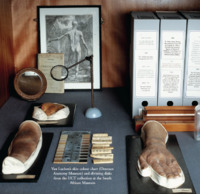Items
Site
The Medicine Chest
keywords is exactly
typology
-

Page 79 of the Curiosity CLXXV catalogue.
"Created by Felix von Luschan, an Austrian doctor, anthropologist, explorer, archaeologist and ethnographer in the early 20th century, the chart, known as the Von Luschan chromatic scale (...) was used to classify skin colour and featured as a tool in race studies and anthropometry of the time. Forgotten by its current department staff and students, its presence draws attention to the role of medicine and science in the apartheid agenda and to the larger racist scientific practices of measuring and classifying human physical differences in the 19th and 20th centuries to produce a ‘typology of race’ (Sturken & Cartwright 2018: 351–352). To support such theories, object collections in scientific university departments worldwide also featured collections of human remains; tools for measuring the size and shape of skulls; and charts detailing various physiognomic features (Sturken & Cartwright 2018: 351 – 352)" (Liebenberg 2021: 122 - 125). -

Curiosity CLXXV
Hiddingh Hall during the construction of the installation of Curiosity CLXXV. -

Hiddingh Hall
Hiddingh Hall prior to the installation of Curiosity CLXXV. -

Miscast (taxonomies)
An extract from an email from archaeologist and former head of African Studies, Prof Nick Shepherd (Jan 21, 2021, 11:33 AM): "Disciplinary practices and regimes of care constitute a kind of bureaucratization or governmentality of elapsed time and its material remains and human relationships, placing these remains and relationships under a kind of administration. We think of the elaborate structure of regional typologies and chronologies, the immense work of correctly assigning artefacts and sites to these imagined categories, and the vast institutional apparatus that supports these endeavors – all of which constitute archaeology as a formidable disciplinary enterprise. In the face of this enterprise, the 'many worlds' of local claims to the past have little chance of success." -

Navigation chart, Micronesia
"Early Pacific seafarers did not have scientific instruments or conventional European-style maps to voyage to, and settle, the thousands of islands of Micronesia and Polynesia. Instead they used the movement of the sea, the direction of the wind, the position of the sun and stars, and the flight of birds. This is a navigation chart, obtained by Georg Irmer, the Governor of the Marshall Islands from Chief Nalu of Jaluit atoll in 1896. The strips of wood, bound by cane, represent the currents and winds, and the six small, white shells represent islands". -

175 chalk-board dusters
For the exhibition, 'Curiosity CLXXV', the curators took an old duster from each teaching venue and replaced it with a new one. -

The conquest of time
An extract from an email from archaeologist and former head of African Studies, Prof Nick Shepherd (Jan 21, 2021, 11:33 AM): "Disciplinary practices and regimes of care constitute a kind of bureaucratization or governmentality of elapsed time and its material remains and human relationships, placing these remains and relationships under a kind of administration. We think of the elaborate structure of regional typologies and chronologies, the immense work of correctly assigning artefacts and sites to these imagined categories, and the vast institutional apparatus that supports these endeavors – all of which constitute archaeology as a formidable disciplinary enterprise. In the face of this enterprise, the “many worlds” of local claims to the past have little chance of success".


